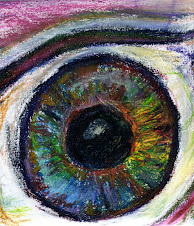If you stare in front of you at a small visual target like a sticker or a spot on the wall you are using your central vision. The longer you maintain that fixation, the more you should become aware that you can also see objects in your peripheral field of vision. The ability to coordinate between your central and peripheral visual systems is very important. Athletes depend on it to sense when an opponent is approaching from behind. Everyone relies on it to remain aware of cars or other potentially dangerous obstacles that should be avoided. Peripheral awareness can actually be improved with practice and certain activities.
For individuals on the Autism Spectrum, however, coordinating and transitioning between the central and peripheral visual fields may be their most significant visual challenge. Many people on the Autism Spectrum repeatedly focus on spinning objects, or on moving lights and shadows. These are enjoyed via the peripheral system. Other people on the spectrum fixate on a pen or pencil that they hold and rotate right in front of their eyes or they cannot be pulled away from small objects or details. These are enjoyed via the central visual system.
As Patricia S. Lemer explains in her helpful book, Envisioning a Bright Future: Interventions that Work for Children and Adults with Autism Spectrum Disorders, learning to coordinate central and peripheral vision may improve a child's attention, focusing, and visual perceptual skills. It may even reduce toe walking and the need to hold onto a wall when walking. Dr. Melvin Kaplan (www.autisticvision.com) wrote a book, Seeing with New Eyes, that explains how these issues can be addressed using therapeutic prisms.
Children who are on the Autism Spectrum may have other visual challenges that can be addressed with the help of a developmental optometrist and a program of in-office vision therapy. They may need glasses to see clearly. You can easily locate an experienced developmental optometrist in your area by plugging your zip code into the search box at www.covd.org. Even if your child is not on the Autism Spectrum, it is important to schedule an annual eye exam with a developmental optometrist and to follow up with the treatment, prescriptions, or therapy that the doctor advises.
Showing posts with label Melvin Kaplan. Show all posts
Showing posts with label Melvin Kaplan. Show all posts
Friday, September 25, 2009
Tuesday, December 30, 2008
Seeing Through New Eyes, By Melvin Kaplan
This book that promises to be able to "change the lives of children with autism, Asperger syndrome, and other developmental disabilities through vision therapy" intrigued me from a number of perspectives. I am an optometric vision therapist so I work with this patient population on a regular basis. I found Kaplan's clinical notes and case studies to be rich with insight as well as technique that I can adopt with some of my patients immediately. I am the aunt of 3 children whose symptoms fall along the autism spectrum so I was interested in whether Kaplan's material would be presented in layman's language. It is. Recently I wrote a series of three books about learning-related visual skills for home schooling families, the Eye Can Too! Read series and have been asked to consider writing a book in the same series to give the home schooling parents of special needs children a series of visually reliant academic activities that they can use. Kaplan's book would definitely be included on my resource list should I end up writing the fourth book. Kaplan's vision therapy evaluation tools for non-verbal patients are great and his explanation of the therapeutic use of yoked prism glasses (while sounding quite mysterious to the uninitiated) is well documented and easy to understand. My only negative comment is that the book takes a long time to read even knowing the terms and activities as I do. However, anyone who wants to understand why some children rock, flap the air, or utilize other stimming behaviors to make sense of their world will gain both empathy and hope that these socially challenging habits can be adjusted by reading Kaplan's book. Well done.
Kaplan, Melvin. Seeing Through New Eyes. Jessica Kingsley Publishers. Philadelphia, London. 2006
Kaplan, Melvin. Seeing Through New Eyes. Jessica Kingsley Publishers. Philadelphia, London. 2006
Subscribe to:
Posts (Atom)




